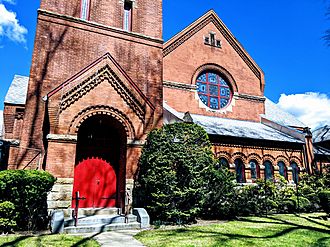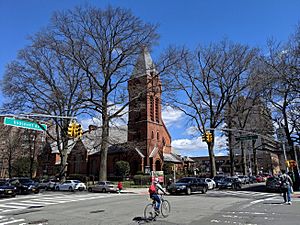Protestant Reformed Dutch Church of Flushing facts for kids
Quick facts for kids Reformed Dutch Church of Flushing |
|
|---|---|

Protestant Reformed Dutch Church of Flushing (Bowne Street Community Church)
|
|
| General information | |
| Architectural style | Romanesque Revival style |
| Location | 143-11 Roosevelt Avenue (38-01 Bowne Street), Flushing, Queens in New York, New York |
| Coordinates | 40°45′42.1″N 73°49′26.7″W / 40.761694°N 73.824083°W |
| Completed | 1892 |
| Governing body | Private |
| Design and construction | |
| Architect | George E. Potter |
| Designated: | December 13, 2016 |
| Reference #: | 2137 |
The Protestant Reformed Dutch Church of Flushing is a special old church in Flushing, Queens, New York City. It is also known as the Bowne Street Community Church. This church was built in a style called Romanesque Revival. It is famous for its tall corner bell tower, beautiful brick designs, and colorful glass windows. The church's history goes back to the early days of New Netherland, which was a Dutch colony in America. Many other churches like this were built in areas where the Dutch settled, especially along the Hudson River.
Contents
History of the Church
How the Church Started
In 1842, seven church members decided to create a new church in Flushing. Four of them came from other Reformed Dutch Churches nearby. The other three were Presbyterians. Together, they formed the Flushing Reformed Dutch Church.
Before this church was built, people in Flushing had to travel to churches in Jamaica or Newtown. Some also worshipped with the Presbyterians at Saint George's. The new church officially became known as the "Protestant Reformed Dutch Church of Flushing" in 1843.
The first church building was put up at the corner of Prince and Washington streets. Today, this is known as 37th Avenue. The first stones for the church were taken from Blackwell's Island, which is now called Roosevelt Island. These stones were laid in August 1843. Later, some of these same stones were used again to build a fireplace in the church building you see today.
By the 1870s, more and more people joined the church. So, they decided to move to a bigger area, further from the busy center of town. In 1873, they bought a large piece of land from Mary B. Parsons. This land was at the corner of Bowne and Amity streets, which is now Roosevelt Avenue. People at the time thought it was "perhaps the best site in Flushing for a church." In 1877, a house for the pastor (called a parsonage) was built on this land. However, it took another 20 years to get enough money to build the church itself.
In December 1890, Reverend James Demarest became the pastor. He was a very respected leader in the Reformed Church. He served the church until 1897. In 1899, the old parsonage was sold to help pay off debts from building the new church. Later, in 1907, a new parsonage was added at 37-16 Parsons Boulevard.
Building the Current Church
The church building you see today was constructed by Edward Richardson. The first stone was laid on October 10, 1891. The church started holding Sunday services in May 1892. It was officially dedicated about six months later, on November 6, 1892. This new church was much taller and larger than the first one. It could hold about 700 people.
Church Design and Features
The church has a large bell tower at its corner. It features beautiful arched doorways and windows. The building also has detailed designs made from brick and stone. Inside, you can see amazing stained-glass windows. These windows were made by the Tiffany Glass Company in New York. A famous designer named Agnes Northrop created them. She was known for her skill with special opalescent glass. The bell in the tower was made by the Meneely Bell Foundry in Troy, New York. The bell tower itself was recognized as a New York City landmark in 2017.
The church also has a large organ. It was made by the Skinner Organ Company in Boston in 1929. This organ has many different parts and sounds. It was made even bigger and better between 1977 and 1988. The organ cost $22,800 in 1929, which would be worth much more today. The church had an older organ from Brooklyn before this one. The very first church building on Washington Street also had an organ.
Church Community
The Reformed Church of Flushing is part of a larger group called the Reformed Church in America (RCA). This group is the oldest Protestant Christian church group in the United States, started in 1628.
In 1851, some members left the original church to form a new one. They created the First Congregational Church of Flushing. This church was located across the street until 1970, when it was destroyed by a fire. As the church grew, an organ was added in 1859. Also, the church started preaching in English instead of Dutch.
The Reformed Church of Flushing and the First Congregational Church of Flushing joined together in 1974. This happened because both churches had fewer members. The population of Flushing changed a lot from the 1930s to the 1970s. It went from mostly white Protestant people to one of the largest Chinese and Korean communities in the United States.
The First Congregational Church, which is part of the United Church of Christ, agreed to the merger in 1970. After they joined, the church's name was changed to the Bowne Street Community Church. It became connected with the Reformed Church in America and the United Church of Christ. Later, in 1988, it also became connected with the Taiwanese Zion Christian Church. An independent Korean church, the New York Yeram Church, also has its offices and holds services there.
See also
- John Bowne House
- List of the oldest Christian denominations in the United States
- List of New York City Designated Landmarks in Queens
- Old Quaker Meeting House (Queens)
- The Weeping Beech
- Chinese in New York City
- Koreatown, Long Island
- Chinatowns in Queens#Flushing


